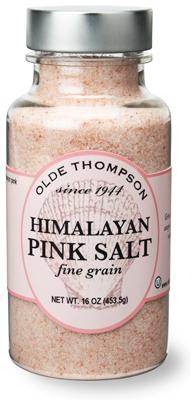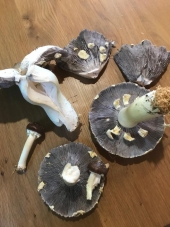
 2
2



















R Ranson wrote:These are really good questions.
I don't know the absolute answer to them... but the theory is that the heart is a muscle, so if it is properly drained (which I always find difficult when home butchering, especially if the animal is stressed when slaughtered, like when we send our animals to the slaughter house to meet their end), then it should, in theory be possibly okay to make jerky from. (butchery is cutting up the animal, slaughter is the killing of the critter, I butcher, I hire out the slaughter. With home slaughter, the animal is less stressed and the organ meat is considerably nicer than when I send the animal to the commercial facility).
Nitrite (and nitrates) are curing salts. They drastically reduce the amount of risk you have with meats spoiling during curing/drying. They are not strictly necessary...HOWEVER, they are useful. They are even more useful if you have never cured meat before as they can help you understand the difference of what safe looks, smells and tastes like.
Okay, this is difficult. I don't know how detailed you want to go into this topic, so I'll start shallow, and if you want to learn more, please ask questions.
I personally recommend using curing salts (as per the recipe recommendation), especially when curing meats for the first time. If you have a heart condition, or have a life threatening reaction to some plastic molecules (because... blabla it's extremely complex - basically if you go into full anaphylaxis if you are in the same room as a synthetic plastic, then don't use (modern) curing salts.)
There are ways to safely substitute salt for curing salts - our ancestors did it, we can too. I'm not comfortable recommending it for making heart jerky. As an organ meat, hearts are a bit less safe than regular muscles. Maybe try a batch of regular jerky first, before trying with a heart.
Also, if you are using heart, or any organ meat, it's important to have a source you can really trust. Personally, I would never use grocery store hearts for this kind of endeavour.
Any questions, feel free to ask.
Edit to add: in some parts of the world, depending on what kind of animal you have and how it was kept, and how it was butchered... blablabla lots of factors, you can get parasites from eating raw heart. This something to be aware of when sourcing your organ meat.




Why are organ meats less safe than muscle meats?
Also isn't the heart a muscle?
My beef comes from a (relatively) local farm that markets itself as having grass-fed, organic cattle. Is that meat at risk of parasites?
What are the risks if I try to cure with pink salt as a novice?


































Updated link for Prague Powder#1 - https://www.stuffers.com/products/rcuprague1-stuffers-prague-powder-no-1-454g-35-case




Supposed I sliced up the heart muscle into small chunks and boiled it for 10 minutes. Would that:
1) kill off any bugs or bacteria
2) render the meat safe for turning into jerky
3) produce jerky that will stay fresh for a couple months if refrigerated?






















R Ranson wrote:Is This it?




R Ranson wrote:I found This recipe for beef heart jerky which might interest you.
Coconut aminos act a lot like a soy sauce, both in flavour and in action. I don't see why the recipe wouldn't work... but if I was making it for myself, I would probably replace the coconut aminos with fish sauce (which is basically fish, salt and water, fermented to make deliciousness) and add a generous amount of salt to the mix. I personally have trouble digesting coconut aminos if they are raw, so that's the only reason I would avoid them. Soy sauce would work as another alternative to coconut aminos, if you don't mind soy. In my case, I would probably use tamari from making Miso with a non-soy bean like chickpeas.




R Ranson wrote:
Supposed I sliced up the heart muscle into small chunks and boiled it for 10 minutes. Would that:
1) kill off any bugs or bacteria
2) render the meat safe for turning into jerky
3) produce jerky that will stay fresh for a couple months if refrigerated?
I've never made jerky with cooked meat before, so I don't know. I imagine there is a change in texture. It also kills off the good bacteria as well as the bad.
To make the heart safe... and I don't know if this works for beef or not... I usually freeze my meat for a few months. This kills off some of the main parasites that are a concern in North America. But I don't know if beef heart has this problem or not... so...?
Maybe for your first jerky adventure, you could start with regular meat, and save the heart for the second jerky making?
Apparently, some people make jerky with ground meat. I've seen lots of recipes for it, but I haven't tried it yet.
I like making jerky with thinly sliced meat. If I were buying the meat, I would go to the Korean grocery store and buy their soup meat, which is very thinly sliced (maybe an 8th of an inch at the most). This makes fast drying, crunchy jerky, which is my favourite. Now, I grow my own meat, I slice it as thin as I can, across the grain. It is easier to slice if it's partly frozen.
I marinade the meat in a salty mixture, usually with spice. I use to use a lot of soy sauce in my marinade, but now I can't eat soy, I often just use salt, fish sauce, chili flakes, and a bit of sugar. Maybe some wine as a base, or sake. After 24 to 48 hours marinating somewhere cool, I dry the meat. Because it's so thin and drying quickly, I'm not so worried about the cure containing curing salts. I store my jerky in an airtight container at room temp. I've found some that was two years old and it was great to eat, but mostly it gets eaten within the first two weeks because it's yummy.
That said, this is the internet and the internet is forever... I don't know your situation. Also, other people might stumble across this post and they all have their own situations I know nothing about. There are things that can go wrong with meat, especially if you don't know the source of your meat. Your source sounds lovely to me... but maybe the next reader isn't as confident with their meat source. Anyway, what I'm saying is that knowing food safety is important... what I do, isn't necessarily what you should do.
So there, that's the disclaimer. People now are much more afraid of meat than they were in the past. But looking at the past, people knew a lot more about how meat interacted with our environment. They made jerky with very little trouble. It can be done. But it's difficult for me to recommend things on the internet because it's meat, and our meat system has changed drastically from that of our great grandparents.
In an imaginary situation, if I wanted to make jerky from heart meat, this is how my first trial would look:
-get a heart from a source I trust, and be confident that it is well drained. My hunter friend cuts a slice in the heart in two not long after it stops beating, so it drains easier.
-slice the heart extremely thin, cut out the artery walls- or whatever you call it, the tubes where the blood goes - because this will be chewy.
-make a salty marinade, with wine, chili, garlic and other spice that helps reduce unwanted bacteria. I imagine Pastirma spices would taste good with heart. Marinade it for 24 to 36 hours.
-dry as quickly as I can.
I have no idea how safe this is. If it was me, I wouldn't worry too much because I'm hypersensitive to smell and taste and can usually tell before the first bite. Apparently most people can't tell... so... I don't know what to suggest.
This site is about experimenting and trying new things... trying to balance caution with encouragement. There is no reason I could see that it wouldn't work... can anyone else chime in on this?
Another source that might be of interest to you. I don't normally recommend Prepper material, as I find Preppers can get a bit... hmmm... however, this one I really liked for an introduction to curing meat: Prep School: Preserving Meat Without Power by Ash Bauer. If I remember right, there is a lot of focus on how to do whole muscle meat curing safely without curing salt.

 2
2











 2
2








John Master wrote:I have incorporated raw beef heart into the usual raw muscle meat to make pemmican, both get sliced thin and dehydrated, then shredded into practically sawdust and covered with tallow or suet. We add maple syrup and dried berries, cranberries work well. This is one of the few foods ever used to sustain large populations for long periods of time. it keeps for months possibly years with no refrigeration. The beef Heart is hi in co-q10 which is good for our own heart/circulatory and overall health and getting raw animal protein (raw milk is another great form, which can get difficult with the current dairy industry) in the diet can be difficult otherwise. this is definitely one of my favorite foods.

|
Message for you sir! I think it is a tiny ad:
Edible Landscaping With a Permaculture Twist by Michael Judd
https://permies.com/wiki/31938/Edible-Landscaping-Permaculture-Twist-Michael
|



